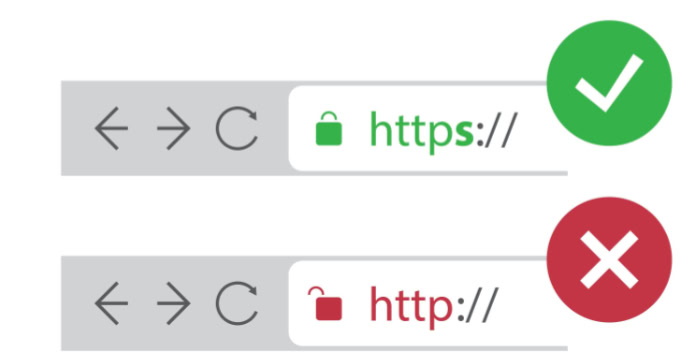HTTP vs. HTTPS: How Encryption Impacts Your Website

Web browsing has come a long way since the early days of the internet, when sending sensitive information over an open connection was commonplace. Evolving threats, stricter privacy regulations, and higher user expectations have pushed web protocols to adapt for greater security, speed, and credibility.
The transition from HTTP to HTTPS stands out as a crucial upgrade, reshaping how data is transmitted and safeguarded online.
Core Protocol Mechanics
Before diving into the security and performance aspects, it is essential to understand how HTTP and HTTPS function on a technical level. Both protocols govern how data moves between a user's browser and a web server, but the ways in which they transmit that information, the ports they use, and the signals they send to users are quite distinct.
These core mechanics shape both the security foundation and the browsing experience.
Data Transmission Methods
HTTP, or HyperText Transfer Protocol, sends data as plaintext. That means any information you enter, whether it’s a search term, password, or sensitive financial detail, travels between your browser and the server visible to anyone who manages to intercept it along the route.
A lack of privacy can expose users to eavesdropping or data theft.
HTTPS, on the other hand, builds an encrypted tunnel between your device and the website using protocols known as SSL (Secure Sockets Layer) or its modern successor, TLS (Transport Layer Security). When a website uses HTTPS, all messages are scrambled in such a way that only the intended server and your browser can decode them.
Establishing this secure channel requires an SSL/TLS certificate, which acts as a digital passport. The web server uses the certificate to prove its identity and establish encrypted communication, ensuring that attackers cannot read or alter the information exchanged.
Ports and Handshake Processes
HTTP and HTTPS also differ in how they manage connections at the network level. HTTP operates using port 80, which is the default channel for unencrypted web traffic.
HTTPS uses port 443, which is specifically reserved for secure communications.
Beyond just port numbers, the process for establishing connections differs. HTTP employs a straightforward TCP handshake to create a connection with the server quickly, since no extra security checks or encryption steps are involved.
HTTPS adds an extra layer: before any data gets transferred, your browser and the server engage in a TLS handshake. During this process, they agree on which encryption methods to use and exchange keys that allow them to encode and decode information.
This handshake introduces a small amount of overhead, but modern improvements in hardware and protocols like TLS 1.3 have made the process almost instantaneous for users.
Visual and Functional Indicators
Browsers have introduced clear visual cues to highlight whether a website uses a secure protocol. When visiting a site over HTTP, many modern browsers now display a “Not Secure” warning in the address bar.
This alert is especially prominent on pages that collect passwords or payment information, signaling to users that their data could be at risk.
Websites served over HTTPS display a padlock icon in the address bar; some may even show the site’s name in green if an extended validation certificate is in use. These symbols are more than decorative.
They reassure visitors that their connection is private and safe from prying eyes. Such confidence can directly influence behavior: users are likelier to enter personal information, complete purchases, or register for services when they see these trust signals.
Conversely, warnings about insecurity can cause visitors to leave immediately, impacting overall engagement.
Security and Privacy Implications

Modern users expect their online interactions to remain confidential, authentic, and protected from outside interference. The protocols chosen for website communications have an immediate impact on the security and privacy of user data.
Examining how HTTP and HTTPS defend against threats, comply with law, and protect sensitive transactions reveals why HTTPS has become the standard across reputable websites.
Threat Mitigation
Sending information over HTTP opens the door to a variety of cyber threats. Eavesdroppers can intercept any data in transit, which means usernames, passwords, and personal details are all vulnerable during transfer.
Tampering is another risk. Without encryption, attackers have the ability to modify content as it flows between the user and the server.
Session hijacking remains a significant concern as well; unencrypted cookies can be stolen, giving malicious actors unauthorized access to accounts.
HTTPS dramatically reduces these risks by creating an encrypted channel between the user and the website. Even if a third party intercepts the communication, the data appears as unintelligible gibberish.
HTTPS also plays a vital role in defending against man-in-the-middle attacks, where an attacker secretly alters or monitors the data exchanged. The encryption and verification steps in HTTPS make it almost impossible for attackers to read or modify information during transfer, providing a much safer online environment.
Sensitive Data Protection
Any web page collecting sensitive information, such as login credentials, payment details, or personal identifiers, must use HTTPS to protect its users. Hackers frequently target unencrypted forms to steal data or hijack user accounts.
APIs and background services, which often transmit confidential information between servers and applications, are also at risk when left unsecured.
Cookies, which manage session states and store user preferences, can be especially vulnerable over HTTP. Unencrypted cookies can be intercepted and used to impersonate a user or gain unauthorized access to private areas of a site.
Data entered into exposed forms can be captured by attackers, compromising user trust and safety. The adoption of HTTPS has become more than just a best practice; it is now essential for preventing the exposure of personal details and maintaining a credible online presence.
SEO and Performance Considerations

A website’s protocol choice has far-reaching effects beyond security. Both search engine optimization (SEO) and performance outcomes can improve or decline depending on whether HTTP or HTTPS is used.
Search engines look for signals of safety and speed, while analytics rely on proper traffic reporting. Performance myths about HTTPS have also lingered, though advances in technology now allow secure connections to be fast and efficient.
Search Engine Rankings
Google has recognized HTTPS as a ranking signal for over a decade, giving secure sites a competitive edge in search results. Search algorithms factor in security as part of a broader push to keep users safe online.
Sites still running on HTTP may find themselves outranked by competitors who offer encrypted connections, even when other ranking factors are similar. In addition to ranking benefits, HTTPS can assist with crawlability and indexation.
Search engine crawlers treat HTTPS URLs as authoritative and may favor them over their HTTP counterparts. Mixed protocol issues or insecure resources can disrupt how a site’s pages are indexed, affecting visibility in search results.
Referral Data Integrity
Maintaining accurate analytics depends heavily on how referral data is passed between websites. When users move from an HTTPS site to an HTTP site, referral data often gets stripped away, leading analytics tools to categorize the visit as “direct” traffic rather than a genuine referral.
This loss of metadata makes it harder for site owners to track where their visitors are actually coming from. On the other hand, HTTPS preserves this referral information, allowing traffic sources to be reported accurately in analytics dashboards.
Marketers and business owners can then make well-informed decisions about where to invest based on reliable data.
Speed Myths and Realities
Concerns about HTTPS slowing down websites are largely outdated. Recent advancements in protocol design have made secure sites just as fast, if not faster, than their unsecured counterparts.
HTTP/2 and HTTP/3, the latest generations of the web protocol stack, require HTTPS for deployment and bring significant improvements in parallelism, header compression, and multiplexing. These upgrades allow pages to load more swiftly and efficiently.
Performance optimizations do not stop there. TLS 1.3, the latest version of the encryption protocol, reduces handshake times, meaning encrypted connections can be established with less overhead.
OCSP stapling helps validate certificates quickly without delays, further speeding up secure connections. As a result, the modern HTTPS-enabled website can offer robust security without sacrificing speed or performance, debunking persistent myths about lag or sluggishness.
Implementation Challenges and Solutions

Migrating a website from HTTP to HTTPS can feel daunting at first. With so many technical details and security best practices to consider, some website owners hesitate to make the switch.
However, the process is much more approachable than it once was.
Certificate Costs and Types
Securing a site with HTTPS begins with obtaining an SSL/TLS certificate. Website owners today benefit from a broad range of options. Free certificate authorities like Let’s Encrypt have made it possible for anyone to add basic security without extra cost.
These certificates provide robust encryption and are trusted by all major browsers, making them an excellent choice for blogs, portfolios, and most business sites.
For organizations seeking higher levels of validation, paid certificates are still widely available. Extended Validation (EV) and Organization Validation (OV) certificates involve additional identity checks, confirming business legitimacy before issuance.
EV certificates typically display the business name alongside the padlock in the browser and signal a higher level of trust. OV certificates offer a balance between strong encryption and business verification.
The right choice depends on brand reputation needs, legal requirements, and the type of information handled. In all cases, installing a certificate unlocks the browser trust indicators that reassure site visitors.
Technical Deployment Steps
Switching from HTTP to HTTPS goes beyond installing a certificate. For a seamless transition, webmasters must configure permanent 301 redirects so that all traffic automatically moves to the secure protocol.
Search engines give ranking priority to HTTPS URLs, so redirecting old links helps retain SEO value and maintain link equity.
Mixed-content warnings often arise after a migration. They occur when a secure page loads assets such as images, scripts, or stylesheets over HTTP.
Browsers may block these elements or flag them as insecure, which can break site functionality or erode user trust. Resolving mixed content requires updating all links and resources to use HTTPS, ensuring every part of the site is served securely.
Many content management systems and modern build tools offer ways to automate this process, but manual checks are often necessary for legacy code or complex sites.
Platform-Specific Guidance
Web servers and content platforms offer various methods for enforcing HTTPS. Apache users can update their .htaccess file with rewrite rules that redirect all HTTP requests to HTTPS.
For example, a simple rule uses mod_rewrite to check the protocol and force a secure connection. Nginx users can achieve the same effect by adding a few lines to the server block, redirecting traffic and specifying the desired certificate files.
Node.js developers can enforce HTTPS by setting up a redirect middleware in popular frameworks like Express. The code checks the request protocol and, if it is not secure, automatically redirects to the HTTPS equivalent.
Content management systems further simplify HTTPS adoption through dedicated tools and plugins. WordPress administrators, for instance, can use plugins that update internal links, fix mixed-content issues, and enforce site-wide security settings with just a few clicks.
Ecommerce platforms such as Shopify offer built-in settings for enabling HTTPS across every page, including payment forms and customer dashboards.
User Trust and Browser Enforcement

Trust plays a central role in how users interact with websites, and browsers have taken an active stance in encouraging secure behavior. As security concerns have grown, browsers deliver clearer warnings and stricter requirements for websites, pushing more site owners to adopt HTTPS.
These changes not only safeguard users but also shape the way people perceive and engage with online content.
Browser Security Warnings
Modern browsers now enforce strict rules around security, alerting visitors when a website fails to provide encrypted connections through HTTPS. For many features, such as geolocation requests, browser notifications, and Progressive Web Apps (PWAs), HTTP-only sites are automatically blocked from accessing them.
Browsers either issue prominent warnings in the address bar or outright prevent certain functions, signaling to users that a site may put their data at risk.
Such warnings have a direct impact on user behavior. When confronted with a “Not Secure” message or a blocked feature, many visitors choose to leave the site immediately.
This reaction can sharply increase bounce rates, which in turn reduces conversion opportunities. For businesses and content creators, ensuring a secure experience is not only about compliance and protection but also about retaining visitor interest and encouraging deeper engagement.
Trust Signals for Visitors
HTTPS provides much more than technical security; it serves as a visible sign of reliability and professionalism. The padlock icon and clear “Secure” labels displayed in browsers help reduce user anxiety.
Visitors are more likely to share information, complete purchases, and engage with interactive features when trust signals are present.
For businesses, blogs, and personal brands, these cues translate into a stronger reputation and more meaningful relationships with audiences. Lacking visible trust indicators, even well-designed sites can struggle to persuade first-time visitors or retain loyal followers.
Security symbols and HTTPS certificates reassure users that their privacy and safety are prioritized.
Progressive Web App (PWA) Requirements
With the rise of advanced web experiences such as Progressive Web Apps, HTTPS has moved from being recommended to being absolutely required. Service workers, crucial for offline functionality, background sync, and push notifications, only operate under secure contexts.
Browsers simply refuse to register these workers or allow installation of a PWA if the site is not served over HTTPS.
Sites preparing to adopt new web standards or offer cutting-edge functionality must prioritize a secure foundation. Committing to HTTPS not only protects today’s visitors but also future-proofs a website for evolving browser requirements and user expectations.
The shift toward HTTPS-driven enforcement reflects broader trends in web development, where security and trust are inseparable from feature-rich user experiences.
Conclusion
Moving from HTTP to HTTPS is no longer optional for any website aiming to provide a safe, trustworthy, and high-performing experience. Encryption shields user data from eavesdropping and tampering, addressing threats that could compromise privacy or security.
Beyond security, HTTPS unlocks real advantages in search engine rankings and ensures referral data stays intact for accurate analytics. Modern protocols and user-friendly tools have made the transition smoother than ever, allowing site owners to implement HTTPS without major disruption.
The padlock icon in the browser has become a universal symbol of reliability, directly impacting how users perceive and interact with any site.
For anyone managing a blog, business site, or web application, immediate adoption of HTTPS is the smartest choice. By prioritizing security and trust today, sites position themselves for ongoing success and readiness for the next generation of web standards.


